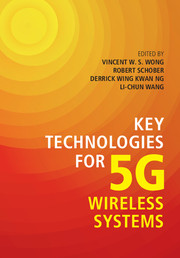Preface
Published online by Cambridge University Press: 28 April 2017
Summary
Mobile devices (e.g., smartphones and tablets) have become a commodity in our daily lives. While these devices already support many different types of applications and services, there will be a continual increase in demand for mobile data traffic due to web applications, real-time and streaming video traffic, and applications related to the Internet of Things (IoT). The future fifth generation (5G) wireless cellular systems aim not only to provide a higher aggregate throughput, but also to support applications which have stringent quality of service (QoS) requirements, such as seamless mobility, ultra-low latency (e.g., Tactile Internet), and high reliability (e.g., vehicular communications). Further improvements in spectrum efficiency, energy efficiency, and cost per bit are also important. In order to meet these demands, fundamental changes to the network architecture and all layers of the protocol stack compared with fourth generation (4G) wireless systems are needed.
This book aims to provide a comprehensive treatment of the ongoing research into and state-of-the-art techniques for addressing the challenges arising from the design of 5G wireless systems. Written by leading experts on the subject, this book includes 22 chapters, which cover various aspects of 5G systems, including network architecture design, physical layer techniques, algorithms, and network protocol design. Chapter 1 serves as an introductory chapter and provides an overview of the different key technologies related to 5G systems. Each of the other chapters tackles one specific challenge for system design. The chapters can be read independently.
This book will be of interest to a readership from the communications, signal processing, and networking communities. The primary audience for this book is researchers and engineers who are interested in studying advanced communication and networking techniques, as well as state-of-the-art research on 5G systems. This book will serve as a resource for self-study and as a reference book for researchers and engineers involved in the design of wireless communication systems. It is also suitable for graduate students who are interested in 5G systems and the related communication and networking issues. It may serve as a reference book for graduate-level courses for students in electrical engineering, communication engineering, and networking.
We would like to thank all the authors for their outstanding contributions and their timeliness in completing their respective chapters. In addition, we would like to thank Elizabeth Horne and Heather Brolly from Cambridge University Press for their valuable advice throughout the production of this book.
Information
- Type
- Chapter
- Information
- Key Technologies for 5G Wireless Systems , pp. xxi - xxiiPublisher: Cambridge University PressPrint publication year: 2017
